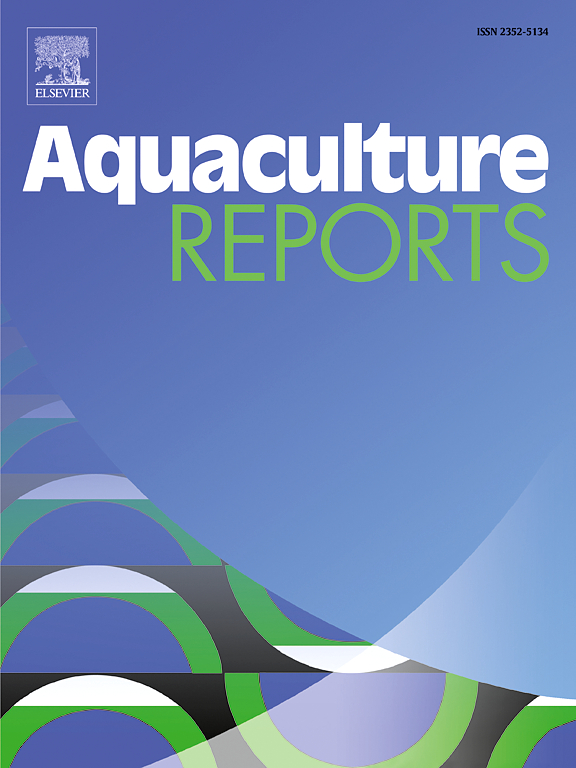A combined use of Panax ginseng extract and the probiotic, Lactobacillus plantarum in the diet of Asian seabass, Lates calcarifer: Effects on growth, immunity and survival after bacterial challenge
IF 3.2
2区 农林科学
Q1 FISHERIES
引用次数: 0
Abstract
This study evaluated the effects of the probiotic Lactobacillus plantarum (LAC-P) and powdered Panax ginseng extract (GINS) on the growth, immunity, and survival of Asian seabass (Lates calcarifer) following a Streptococcus iniae infection. Eight groups were tested: control, LAC-P (1 × 1010 CFU L. plantarum /100 g diet), varying doses of GINS (0.1 %, 0.5 %, 1 %), and combinations of LAC-P with these doses of GINS. All experiments were carried out in three replicates and fish (Mean weight: 25.3 ± 4.2 g) of all treatments fed for 60 days. After this feeding period, a challenge test was also done with Streptococcus iniae over 14 days. The growth performance and digestive enzyme activities (trypsin, chymotrypsin, lipase) significantly improved in fish supplemented with LAC-P and LAC-P + GINS (0.1–1 %) (P < 0.01). The treatment, LAC-P + GINS (1 %) showed highest performance, as a final weight, weight gain, specific growth rate and feed conversion ratio of 81.4 ± 4.1 g, 223.6 ± 7.3 %, 1.94 ± 0.07 % and 1.1 ± 0.02 respectively obtained for this treatment (P < 0.01). This treatment also showed highest digestive enzyme activities for trypsin (5.2 ± 0.11 U/mg protein), chymotrypsin (3.9 ± 0.15 U/mg protein) and lipase (2.12 ± 0.04 U/mg protein) (P < 0.01). The intestinal lactic acid bacteria with maximum load of 4.1 ± 0.5, 3.9 ± 0.5 and 3.6 ± 0.4 log CFU/g intestine at LAC-P + GINS treatments, increased, following the probiotic administration, while total bacterial count remained unchanged (P < 0.01). The antioxidant enzyme activities in blood significantly increased in response to LAC-P, GINS (0.5–1 %) and their combinations compared to control (P < 0.01). The highest activity of Superoxide dismutase (5.44 ± 0.62 U/mg), catalase (15.68 ± 1.04 U/mg) and glutathione peroxidase (14.5 ± 2.4 U/mg) was observed in LAC-P + GINS (1 %) treatment (P < 0.01). Also, LAC-P and GINS alone and their combinations enhanced total antioxidant capacity (T-AOC), with highest-value for fish of LAC-P + GINS (1 %) (0.4 ± 0.05 U/mg protein) and LAC-P + GINS (0.5 %) (0.34 ± 0.04 U/mg protein) (P < 0.01). The immune components of serum [total immunoglobulin (Ig), lysozyme (lyz), alternative complement activity (ACH50), myeloperoxidase (MPO), nitroblue tetrazolium (NBT), total protein] and mucus [protease, Ig, alkaline phosphatase (ALP), Lyz] were mostly elevated in fish supplemented with LAC-P, GINS (1 %) and LAC-P + GINS (0.1–1 %) (P < 0.01). The maximum elevations of immune components of serum (Ig: 6.5 ± 0.4 mg/ml, lyz: 180.6 ± 6.8 U/ml), ACH50: 60.2 ± 5.06 U/ml, MPO: 4.24 ± 0.19 OD at 450 nm, NBT: 0.4.6 ± 0.03 OD at 620 nm and total protein: 4.1 ± 0.22 g/dl) and mucus (protease: 16.2 ± 2.4 U/ml, alkaline phosphatase: 4.9 ± 0.3 U/ml, Ig: 2.37 ± 0.2 mg/ml, lyz: 101.4 ± 5.09 U/ml) mostly were for LAC-P + GINS (1 %) treatment (P < 0.01). Supplementation of fish with GINS alone or combined with LAC-P significantly mitigated oxidative stress, as malondialdehyde (MDA) levels decreased in these treatments (P < 0.01). The most reductions in MDA (17.3 ± 2.1 nmol/L) observed in the LAC-P + GINS (1 %) treatment (P < 0.01). After bacterial challenge, fish fed supplementation with GINS (0.5 %), GINS (1 %) and LAC-P + GINS (0.1–1 %) showed lower mortality rate (P < 0.01). LAC-P + GINS (1 %) treatment showed the lowest (35.2 ± 4.5 %) fish mortality (P < 0.01). In conclusion, fish supplemented with LAC-P and GINS, especially at 1 % level, showed significant improvements in growth, digestive enzyme activities, antioxidant enzyme levels, and immune responses. The combination of LAC-P and GINS (1 %) resulted in the lowest mortality rate and best overall performance, demonstrating their potential for enhancing fish immunity against the bacterial challenge.
求助全文
约1分钟内获得全文
求助全文
来源期刊

Aquaculture Reports
Agricultural and Biological Sciences-Animal Science and Zoology
CiteScore
5.90
自引率
8.10%
发文量
469
审稿时长
77 days
期刊介绍:
Aquaculture Reports will publish original research papers and reviews documenting outstanding science with a regional context and focus, answering the need for high quality information on novel species, systems and regions in emerging areas of aquaculture research and development, such as integrated multi-trophic aquaculture, urban aquaculture, ornamental, unfed aquaculture, offshore aquaculture and others. Papers having industry research as priority and encompassing product development research or current industry practice are encouraged.
 求助内容:
求助内容: 应助结果提醒方式:
应助结果提醒方式:


